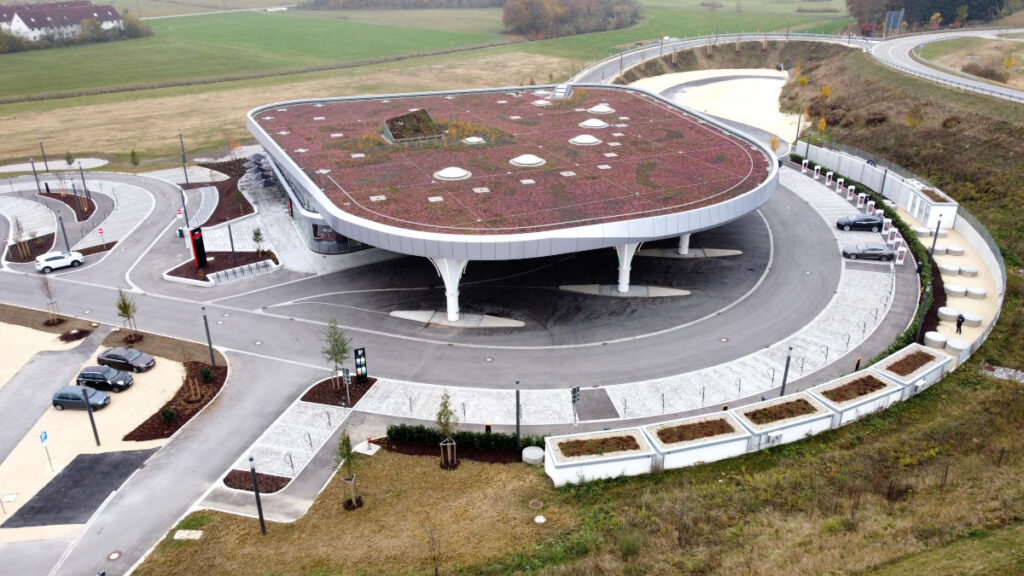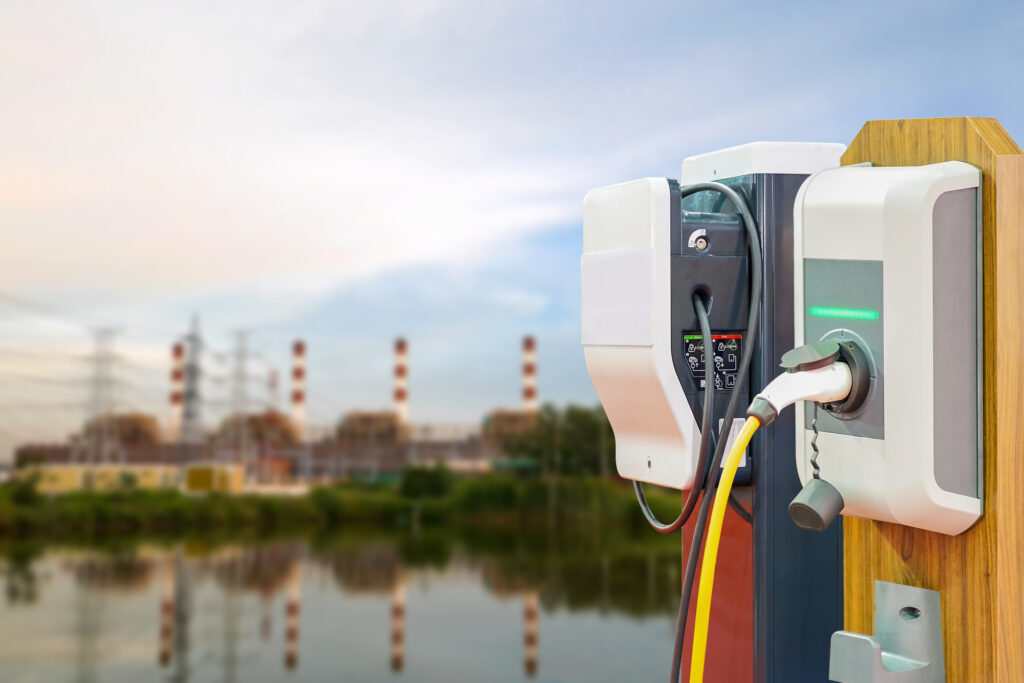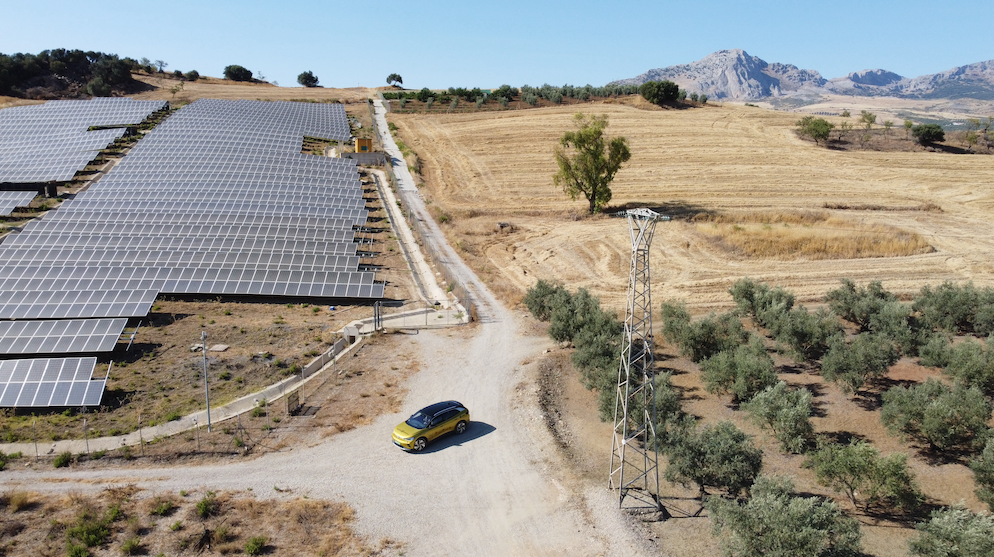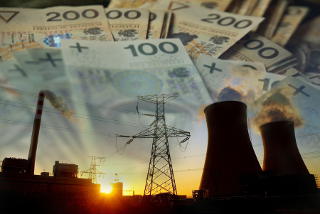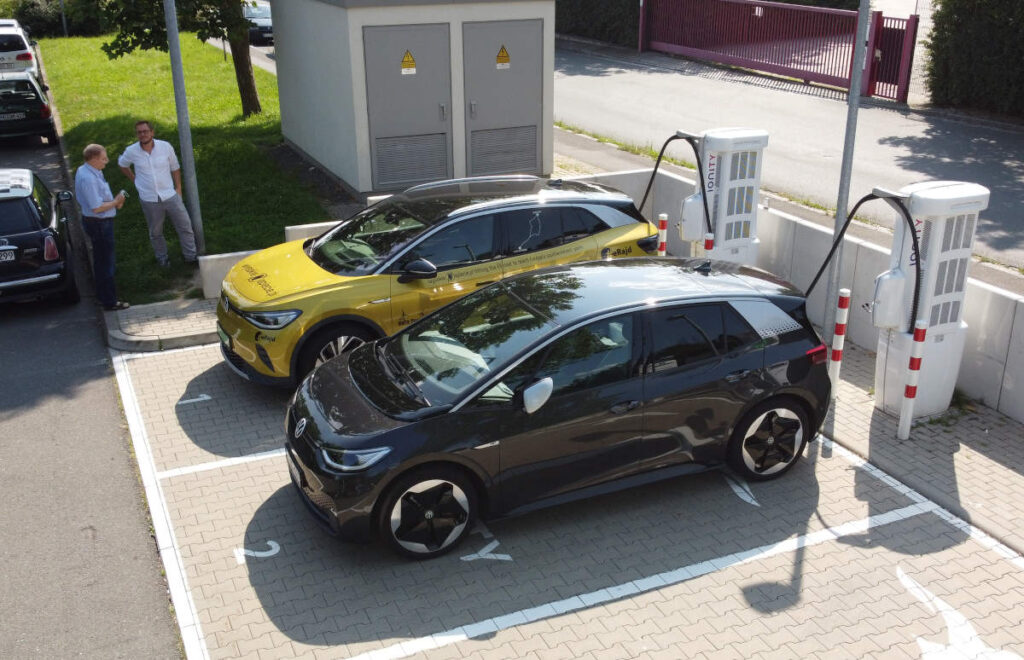Spis treści
It was worth to select this location as a charging spot during our trip from Warsaw to the Alps in a fully electric EQV Mercedes. Sortimo lnnovationspark in a tiny Bavarian Zusmarshausen is by far the most spectacular e-car charging station in Europe. In our editorial ranking of several hundred of charging stations in European countries, we applied for testing e-cars on long routes, it overthrew the current leader — Ekoen from Zielona Góra.
The very building itself made our five person team bewildered. It looks like it has been taken from an American cartoon “The Jetsons”. Rounded shapes, pillars extending as treetops and white facade make this futuristic building of an exceptional one, linking nature with technology. Anyway, both the nature and technology are the causative force of the origin of this place. It is the biggest fast and ultra-fast charging station of electric cars in Europe.
74 fast charging spots
E-cars drivers have at their disposal 24 charging spots, providing up to 4T5 kW power each and 38 spots capable of providing up to 140 kW. Besides, there are also 12 Tesla super-chargers with 250 kW of power each. In total, we have 74 spots (only CCS 2) of fast and ultra-fast charging in a single location. More than in whole Poland and the whole infrastructure has already been prepared for development up to 144 charging spots.
The phrase “capable of providing up to” is of a key importance due to three reasons. Firstly, there is no vehicle on the market capable of taking more than 270 kW of charging power. Secondly, international organization that develops CCS (CharlN) connection has not yet agreed on a charging standard for 475 kW (950V and SOOA) power. Thirdly, currently the station provides charging with different powers through the same wires. If we stay for breakfast there (as we did on our trip) or dinner, we may use 35 or 70 kW power, instead of 105 or 280 kW, as we are bound to stay there for an hour or so and not for 15 minutes. We will pay less for lower power intake.
Internal direct current grid
However, the power at each charging spot, depending on the requirements, can be increased (up to 140 or 475 kW). This is guaranteed by the architecture of the whole station. Instead of multiple single chargers at each spot, it is equipped with a single central charger distributing power to each spot by direct current. There is 6m of such wires embedded in the station, transferring direct current at voltage of up to 950 V. Similar solutions have been applied for Tesla super-chargers for years, and also since recently, ultra-fast charging stations, such as lonity or Fastned. Due to such centralized solution it is possible to use waste heat generated during charging. It heats both the very station building as well as it is directed to the local heating network.
Charging cables have been mounted in a new arrangement. The fastest ones are fixed on four sides of each of the 6, several meters high, pillars that support the roof of the building. The cables are not laid on the ground -they are suspended from the pillars. Thus, they are clean and easy to connect which is of a great significance at such cable weight and thickness. On the other hand, slightly narrower charging cables of powers of up to 140 kW are provided as flexible poles which can easily be dragged depending on a car charging port location.
Next app on your mobile
In theory, it provides friendly way no only to charge your car, but also to pay for the service. According to the station operator, it can be done both via your application as at the shop counter, as a credit card or cash payment. We checked the second option out of curiosity, but a casher asked us to download the app.
So we had to come down to earth – we needed the NEXT mobile app. We managed to download it quickly, inserted a card and started our charging without any issues, however, it was not what we would have expected from such an ultra-comfy charging station. One is not able to use any roaming card as well, as the station is not equipped with any RFID card reader or a screen that displays anything. Only in future, when vehicle – charging station communication standard becomes more widely used, and allows for automatic car identification and charging service settlement, we might use the station without any need of registering a new account in yet another application. Well, we’ll see.
Our nerves frayed by this electric mobility illness were, however, quickly healed in a fabulously looking and providing excellent food restaurant. Here you can visit quite spacious grocery store and a bakery, and during the night, when all service points are closed, you can try snack and coffee machines, taking a seat at the table. During the night, electric car drivers have to their disposal toilets available free of charge which is quite rare in Germany.
How much power does this charging station need?
Some readers might wonder about the power such station requires. So are we. Unfortunately, we did not manage to get this question answered. Obviously, simple multiplication of maximum available powers by a number of charging spots makes no sense. The result would then be 20 MW, but clearly this is the load the station will never reach (at a present number of charging spots). First of all, the situation in which all charging spots are occupied might occur once or twice a year, before holidays. So it is of no use to over-calculate its capabilities for such rare occasions. Secondly, even if all spots are occupied, each vehicle will not be charged at full power – part of them will even not accept such fast charging, and what is more, the power taken by e-cars decreases along the battery level increase.
The operator of the station points out that it is prepared to deliver 240 MWh daily which would mean the assumed load at the average level of 10 MW. However, it does not mean that such power is, or will be needed in the near future. Due to charging central arrangement, with an increase of interest in the station services, the operator can embed subsequent modules providing power at the level of real demand. At present, even with Tesla super-chargers, the demand of the whole station is not likely to exceed 3-5 MW.
How much is an e-car charging?
How much will you pay for the pleasure of you e-car charging at Sortimo lnnovationspark? This depends on the charging power you wish to use. For charging with power of up to 35 kW you will pay 35 Euro cents per kWh. For 70 kW you will pay 49 ct, for 105 kW 59 ct, and for the fastest charging (accepted by vehicles which are currently on the market – up to — 280 kW) you will 69 ct/kWh. These are the prices comparable to the rates common in Poland. Provided you have no license subscription paid (then you may pay significantly less for charging). As for now, Sortimo does not provide an option of such license subscription yet. However, due to ongoing infrastructure tests (the station was launched 3 months go), charging rates, even in the case of connections for the highest powers, were reduced to 35 ct/kWh (1.60 PLN/kWh).
To charge EQV Mercedes we travel by, we had to pay 56 PLN/100 km. Fully packed vehicle, on winter tires, with 5 passengers and dual-zone heating (at outside temperature approx. 8 degrees. C), consumes approx. 35 kWh/100 km while driving at the speed of around 120 km/h. The same model, equipped with an diesel engine, consumed 9,31/100 km on this route which, at present fuel prices, would mean the cost of approximately 65 PLN /100 km.
Is this the way electric mobility will turn into?
The idea of construction of such extraordinary charging station was invented by the managers of German Sortimo which produces custom made trucks. The charging hub was located on a plot opposite to Sortimo facility. So it is an example resembling the 2 place on our list of the best charging stations in Europe – namely, Ekoen, which was constructed at the production facility of Ekoenergetyka in Zielona Góra, being one of the European leaders in manufacturing chargers for electric buses. The management board of Ekoenergetyka announced the Ekoen project would be continued. However, it is hindered by the costs – construction of such station is simply too expensive. Currently, charger networks are developed based on the existing infrastructure (at fuel stations or on supermarket parking lots). It can be similar in case of Sortimo lnnovationspark. The question remains whether after the market has been won by e-cars, will a number of such big, well developed and modern stations grow? It is likely to be so, but as for now one must get an impression that this station is ahead of its time. It is only that the epochs in electric mobility development last single years.


